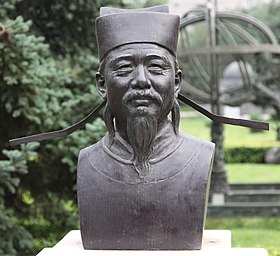Shen Kuo 沈括 | |
|---|---|
 Bust of Shen at the Beijing Ancient Observatory | |
| Born | 1031 |
| Died | 1095 (aged 63–64) Runzhou, Song Empire |
| Known for | Geomorphology, Climate change, Atmospheric refraction, True north, Retrogradation, Camera obscura, Raised-relief map, fixing the position of the pole star, correcting lunar and solar errors |
| Scientific career | |
| Fields | Agronomy, Astronomy, Archaeology, Anatomy, Antiquarianism, Mathematics, Pharmacology, Medical science, Entomology, Mineralogy, Music, Geomorphology, Sedimentology, Optical engineering, Soil science, Encyclopedism, Geomagnetics, Optics, Hydraulics, Hydraulic engineering, Mechanical engineering, Metallurgy, Metaphysics, Meteorology, Climatology, Cartography, Botany, Zoology, Economics, Finance, Military strategy, Ethnography, Divination, Art criticism, Philosophy, Poetry, Politics, Public Administration |
| Institutions | Hanlin Academy |
| Shen Kuo | |||||||||||||||||||||||||||||
|---|---|---|---|---|---|---|---|---|---|---|---|---|---|---|---|---|---|---|---|---|---|---|---|---|---|---|---|---|---|
"Shen Kuo" in regular Chinese characters | |||||||||||||||||||||||||||||
| Chinese | 沈括 | ||||||||||||||||||||||||||||
| |||||||||||||||||||||||||||||
Shen Kuo[a] (Chinese: 沈括; 1031–1095) or Shen Gua[b], courtesy name Cunzhong (存中) and pseudonym Mengqi (now usually given as Mengxi) Weng (夢溪翁),[1] was a Chinese polymath, scientist, and statesman of the Song dynasty (960–1279). Shen was a master in many fields of study including mathematics, optics, and horology. In his career as a civil servant, he became a finance minister, governmental state inspector, head official for the Bureau of Astronomy in the Song court, Assistant Minister of Imperial Hospitality, and also served as an academic chancellor.[2] At court his political allegiance was to the Reformist faction known as the New Policies Group, headed by Chancellor Wang Anshi (1021–1085).
In his Dream Pool Essays or Dream Torrent Essays[3] (夢溪筆談; Mengxi Bitan) of 1088, Shen was the first to describe the magnetic needle compass, which would be used for navigation (first described in Europe by Alexander Neckam in 1187).[4][5] Shen discovered the concept of true north in terms of magnetic declination towards the north pole,[5] with experimentation of suspended magnetic needles and "the improved meridian determined by Shen's [astronomical] measurement of the distance between the pole star and true north".[6] This was the decisive step in human history to make compasses more useful for navigation, and may have been a concept unknown in Europe for another four hundred years (evidence of German sundials made circa 1450 show markings similar to Chinese geomancers' compasses in regard to declination).[7]
Alongside his colleague Wei Pu, Shen planned to map the orbital paths of the Moon and the planets in an intensive five-year project involving daily observations, yet this was thwarted by political opponents at court.[8] To aid his work in astronomy, Shen Kuo made improved designs of the armillary sphere, gnomon, sighting tube, and invented a new type of inflow water clock. Shen Kuo devised a geological hypothesis for land formation (geomorphology), based upon findings of inland marine fossils, knowledge of soil erosion, and the deposition of silt.[9] He also proposed a hypothesis of gradual climate change, after observing ancient petrified bamboos that were preserved underground in a dry northern habitat that would not support bamboo growth in his time. He was the first literary figure in China to mention the use of the drydock to repair boats suspended out of water, and also wrote of the effectiveness of the relatively new invention of the canal pound lock. Although not the first to invent camera obscura, Shen noted the relation of the focal point of a concave mirror and that of the pinhole. Shen wrote extensively about movable type printing invented by Bi Sheng (990–1051), and because of his written works the legacy of Bi Sheng and the modern understanding of the earliest movable type has been handed down to later generations.[10] Following an old tradition in China, Shen created a raised-relief map while inspecting borderlands. His description of an ancient crossbow mechanism he unearthed as an amateur archaeologist proved to be a Jacob's staff, a surveying tool which wasn't known in Europe until described by Levi ben Gerson in 1321.
Shen Kuo wrote several other books besides the Dream Pool Essays, yet much of the writing in his other books has not survived. Some of Shen's poetry was preserved in posthumous written works. Although much of his focus was on technical and scientific issues, he had an interest in divination and the supernatural, the latter including his vivid description of unidentified flying objects from eyewitness testimony. He also wrote commentary on ancient Daoist and Confucian texts.
Cite error: There are <ref group=lower-alpha> tags or {{efn}} templates on this page, but the references will not show without a {{reflist|group=lower-alpha}} template or {{notelist}} template (see the help page).
- ^ Yao (2003), 544.
- ^ Needham (1986), Volume 4, Part 2, 33.
- ^ John Makeham (2008). China: The World's Oldest Living Civilization Revealed. Thames & Hudson. p. 239. ISBN 978-0-500-25142-3.
- ^ Bowman (2000), 599.
- ^ a b Mohn (2003), 1.
- ^ Sivin (1995), III, 22.
- ^ Embree (1997), 843.
- ^ Cite error: The named reference
sivin 1995 III 18was invoked but never defined (see the help page). - ^ Sivin (1995), III, 23–24.
- ^ Cite error: The named reference
bowman 2000 105was invoked but never defined (see the help page).